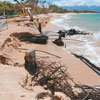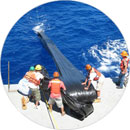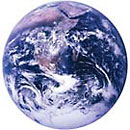the School
Outreach
Announcements
For other announcements, including weekly seminars, please see the SOEST Bulletin.
G. Jeffrey Taylor to Receive Carl Sagan Medal

Hawai‘i Institute of Geophysics and Planetology (HIGP) planetary scientist Jeff Taylor has been named the 2008 recipient of the Carl Sagan Medal for Excellence in Public Communication in Planetary Science.
The prize recognizes and honors outstanding contributions by active planetary scientists to the public's understanding of, and enthusiasm for, planetary science. Taylor is the ninth recipient of the Sagan Medal and the first from UH.
Read more about it in the SOEST press release (PDF).
SOEST Young Investigator Postdoctoral Program Invites Applications
We are seeking junior scientists and engineers with outstanding abilities. See the SYI page for more information.
Hawai‘i’s Dynamic Ocean: Hawai‘i Ocean Observing System Lecture Series
August 2008 – February 2009
Starts Wed 13 Aug • 6 pm
in the Outrigger Waikiki Hotel’s “Kalakaua Room”
(2335 Kalakaua Ave).
Download the flyer PDF for the detailed schedule of lectures.
Hanauma Bay Education Program celebrates 2008 Internat’l Year of the Reef
Lei Ko‘a:
Exploring the Reefs that Surround our Islands
Every 4th Saturday through Sept. 2008 • 6-9 pm
For more information on these fun, educational, and FREE events, call (808) 397-5840, send us e-mail, or visit the UH News page.
SOEST in the News
Hawai‘i Ocean Observing System profiled on Hawai‘i Public Radio
Listen to the mp3 from the HPR website. Image courtesy of HiOOS. HIMB researchers comment on recent shark attacks, sightings
Read more about it and see the video at HonoluluAdvertiser.com and KGMB9. Image courtesy Hawaiian Lifeguard Association. Beach erosion spreading on islands of O‘ahu and Maui
Read more about it in the Honolulu Advertiser (O‘ahu) and the Maui News (Maui). Photo courtesy of Matthew Thayer/Maui News; click on it to see the full version. “Artificial upwelling” project focus of Discovery Channel programHOT and C-MORE oceanographers led by Dave Karl and Ricardo Letelier were highlighted in the new Discovery Channel series called Discovery Project Earth. The “Hungry Oceans” episode showed how researchers are looking at wave-powered ocean pumps that could increase ocean productivity and decrease carbon dioxide in the atmosphere. The show premiered on Friday, September 5, 2008, at 7 pm HST on the Discovery Channel, with a rebroadcast the following Sunday morning. Read more about it in the Honolulu Star-Bulletin, the SOEST Press Release (PDF), at EurekAlert, and at UPI.com. Image courtesy of the Dave Karl, et al.; click on it to see the full version.
| ||
SOEST Quicklinks |
||
Environmental Conditions
SOEST Emergency Information
Marine Operations
[ Top of this page ] |
Technical, Web, and Other Support
EmploymentThe Dean’s Overview of the School
|
|


 Hawai‘i Institute for Marine Biology (
Hawai‘i Institute for Marine Biology (

 Three Top-Ten Rankings for SOEST Programs
Three Top-Ten Rankings for SOEST Programs BE PREPARED :
BE PREPARED : 
